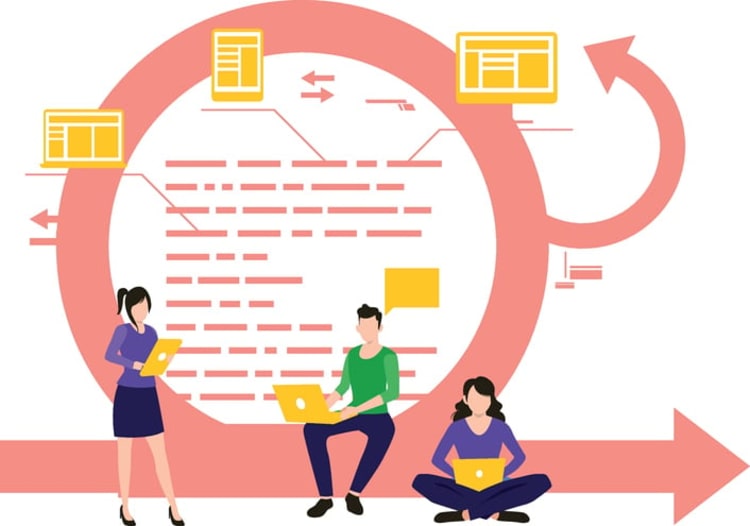Agile development is a popular and highly effective software development methodology. Over recent years, this innovative approach has been a fantastic addition to traditional linear practices. Agility is defined as the ability to move quickly and easily, and agile development meets this goal through feedback, self-organization, and cross-functionality. Learning lessons from evolution with an eye to continual improvement, agile development is quickly becoming the new normal.
From a practical perspective, agile development is about swapping long-term frameworks for actionable sprints and short-term deliverables. While planning is still crucial, an adaptive approach is used to inform the development and tighten the loop between work performed and value created. The importance of this approach cannot be overstated, with developers benefiting from greater control, reduced risk, better decision-making, and superior outcomes.
History of agile development
To understand the importance of agile development, you need to know the history behind it. While flexibility has always been part of software creation and digital transformation, early chapters were very regulated and extremely linear. This worked well during the early decades, but the proliferation and maturity of software services called for a different approach in the 1990s.
Before then, software development was based on a "waterfall" model, which was highly regulated, overplanned, and micromanaged. This approach became increasingly "heavy," with developers often feeling bogged down by linear sequential phases. Progress flowed in one direction from conception to deployment, and each phase was dependent on previous deliverables. After a while, a more sophisticated approach was needed to mirror the intellectual and cultural changes taking place at the time.
Agile development respects multiple pathways to completion based on iterative growth cycles. It started with rapid application development (RAD) and the dynamic systems development method (DSDM) in the early '90s, grew with extreme programming (XP) and feature-driven development (FDD) in the late '90s, and was cemented by the publication of the Manifesto for Agile Software Development in 2001.

Agile development principles
At the start of the new millennium, software was more important than ever before. There was a growing appetite for change in the industry, and a new agile approach was needed to ensure efficient and effective development. This has only accelerated in recent years, with cloud computing, remote work, and synchronous communication as ideal breeding grounds for a more agile approach.
The Agile Manifesto
The Agile Manifesto was formulated by 17 software developers at a resort in Snowbird, Utah. The growing need for lightweight development methods had become obvious, and these key people had the vision and experience needed to lay down the fundamental values.
Key principles and values
To understand agile development, you need to know its core principles and values. The following four values and 12 principles were declared by the authors of the Manifesto for Agile Software Development:
Agile development values
- Individuals and interactions over processes and tools
- Working software over comprehensive documentation
- Customer collaboration over contract negotiation
- Responding to change by following a plan
Agile development principles
- Customer satisfaction by early and continuous delivery of valuable software.
- Welcome changing requirements, even in late development.
- Deliver working software frequently (weeks rather than months).
- Close, daily cooperation between business people and developers.
- Projects are built around motivated individuals, who should be trusted.
- Face-to-face conversation is the best form of communication (co-location).
- Working software is the primary measure of progress.
- Sustainable development, able to maintain a constant pace.
- Continuous attention to technical excellence and good design.
- Simplicity—the art of maximizing the amount of work not done—is essential.
- Best architectures, requirements, and designs emerge from self-organizing teams.
- Regularly, the team reflects on how to become more effective and adjusts accordingly.

Popular agile methodologies
A number of methodologies have been developed around agile development. Different technologies and practices highlight the need for agility and decision-making. All corners of the software ecosystem are affected, and the following methodologies are among the most popular:
Scrum
Scrum is all about teamwork, with tasks divided into manageable chunks and performed by 7-9 people. The fundamental principle of Scrum is the division of time and projects into field-length iterations called sprints.
Kanban
Kanban is a framework dedicated to communication and transparency. Developers learn from each other in real-time by focusing on a visualized workflow where projects are broken down into smaller tasks.
Extreme Programming (XP)
This highly disciplined development method is about continuously delivering high-quality software. XP methodology works on five core values: simplicity, communication, feedback, courage, and respect.
Feature-Driven Development (FDD)
This methodology emphasizes quality and prioritizes short processes. New features are delivered across iterations, and accurate progress information is provided to ensure compatibility and timely delivery.
Lean software development
Lean is about developing a project by focusing on what the customer wants. To do this properly, you need to eliminate all non-value-adding activities and prioritize delivery by developing in small batches.

Comparison of methodologies
When choosing an agile development methodology, it's important to think about the size of your project, the timeline you're working with, and the criticality of development components. Management and team skills also come into play, as do details of customer involvement, organizational culture, and project constraints. Expertise is also likely to play a role, with people experienced in a particular methodology more likely to continue with it.
Each development method has its own inherent advantages, with a detailed comparison needed at the start of every project. For example, Scrum is ideal for small-defined groups, Kanban works when clients demand transparency, XP requires high-level programming skills, FDD is ideal for sequential development, and Lean is perfect for customer-focused projects. Project management also needs to consider size, with Scrum perfect for small projects, FDD ideal for very large projects, and other methodologies somewhere in between.

Implementing agile development methodology
When implementing an agile development methodology, it's important to plan ahead and develop a thorough understanding of working methods and environments. The decisions you make at the start can affect all aspects of project management, so be clear about your goals and choose a methodology that aligns with your level of expertise.
The following steps should give you a solid working framework:
- Identify project scope and objectives.
- Assemble an agile team.
- Select the appropriate agile methodology.
- Set up the project environment.
- Plan and execute iterations.
Benefits of agile software development
Regardless of your project's size or complexity, agile development offers a range of advantages. From more efficient deployment to improved transparency and faster time to market, the following advantages are among the most critical:
More efficient deployment
Agile development methods can be deployed much faster and more efficiently than traditional linear pathways. When large projects are broken down into bite-sized pieces and given to small on-site or remote teams, you can start quicker and work faster.
Improved productivity
The initial aim of agile software development is to boost productivity. This occurs on many fronts, with feedback and iteration leading to greater control, better risk management, and continual improvement.
Enhanced collaboration
Agile methodologies foster an open culture based on communication and teamwork. With individual nodes collaborating and sharing ideas, both on-site and remotely, team members learn from shared experiences and improve together.

Greater transparency
Agile development means improved transparency, both within teams and between developers and clients. The customer can be engaged throughout the process, which leads to more accurate decision-making and better quality control.
Faster time to market
When teams collaborate, and developers communicate with clients, products are developed much faster. Increased flexibility in all aspects of development leads to improved visibility, risk detection, and quicker time to market.
Higher customer satisfaction
Customers and end users are much happier when they're involved with the development process. End products are more likely to exceed expectations, risks are greatly reduced, and both customer and staff satisfaction are boosted.
Greater flexibility and adaptability
Flexibility is the cornerstone of agile development. When large tasks are broken down and delivered continuously, feedback is more efficient and results come faster. This allows project managers to adapt resources and adjust timelines accordingly.

Challenges and pitfalls of Agile development
Despite the many advantages of agile development, there are some challenges associated with this way of working. Before starting a new project, it's important to be aware of potential pitfalls and put appropriate prevention measures in place. Regardless of project size or specialization, most challenges fall into one of these two categories:
Inconsistent systems, processes, and practices
Agile development practices may need to overcome inconsistencies between systems, processes, and practices. Most organizations are heavily invested in particular technologies and systems, and change can be a tough pill to swallow. If you get involved with Agile Methodology for a particular project or within a single department, translating this value company-wide can be very difficult.
Inconsistencies take numerous forms, from different training, education, and support regimes to fragmented processes, technologies, and measurement systems. To overcome these problems, it's important to engage management and create a network of services across your organization. When you include bosses, departments, teams, and individuals, self-similar systems can evolve over time on multiple fractal levels.
Resistance to change on all levels
One of the biggest challenges associated with agile development is resistance to change. This resistance takes many forms, from lack of management support and divergent cultural values to internal resistance within teams. While you can do lots of things to encourage participation and facilitate progress, some hurdles can be hard to overcome.
For example, aligning with every level of management can be difficult, and corporate values can take years before they're cemented. In all cases, communication is the key to overcoming resistance. When people truly understand the benefits of agile development, they're more likely to get involved and become part of the solution.

Case studies
There are numerous examples of companies successfully using agile development. Along with digital transformation and the rapid rise of remote work, it's been a key defining trend over recent decades. While moving away from the linear waterfall model can be challenging, it has proven to work time and time again. From multinational giants such as Lego and Cisco to trusted national institutions like British Telecom, the following success stories should inspire confidence in any organization.
Lego
The Danish toy giant initiated agile development practices fairly late, with the Scaled Agile Framework (SAFe) adopted in 2015. Since then, all 20 product teams working at Lego have transformed into self-organizing Scrum teams. This added a level of abstraction at the program level to enable deeper collaboration, and it also worked at the portfolio level to support top management and other stakeholders. Agile development has allowed Lego to produce more accurate estimates, reduce unproductive practices, and boost team morale.
Cisco
Cisco also started using the Scaled Agile Framework (SAFe) back in 2015. The company used to use a fairly traditional waterfall model, with separate teams responsible for product design, building, testing, and deployment. This led to numerous problems with quality control and deadline management, which had follow-on effects on team morale and staff loyalty. Cisco created three ARTs (Agile Release Trains) for capabilities, defects/fixes, and projects, with this process helping to reduce operational problems and maximize savings.
British Telecom
The British telecommunications powerhouse became agile much earlier, with Scrum and XP adopted in 2004. Before then, British Telecom was struggling with operational inefficiencies and excessive intermediaries, which put pressure on deployment, development, and employee morale. A continuous delivery model was adopted early in the agile process, with smaller and more frequent iterations helping the company with deadlines and service quality.
There are many lessons to learn from these examples, which are far from isolated and relevant to all industry sectors. If some of the largest organizations in the world can successfully adopt agile development, small and medium-sized enterprises should feel confident about the migration process.

Future trends and developments
The widespread adoption of agile development is almost certain. While the mechanisms behind this approach are not set in stone, current trends highlight definitive pathways based on innovation and resilience. The future will set new pathways in an effort to streamline complex production and organizational processes. When problems are identified early and improvements are made quickly, value can be delivered across timelines and scales.
The following strong trends have emerged over recent years, and they don't look like they’re disappearing any time soon:
- Scaled development practices
- Cloud-based products and services
- Customer-centric design thinking
- AI and machine learning tools
- Tighter feedback and rapid testing
- Integrated DevOps methods
If you're ready to adopt agile development in your organization, there are lots of methods at your disposal. When you understand the key principles and values associated with this transformative approach, you can choose the right methodology for your organization and leverage its many benefits. Please contact Kumospace to learn more.
FAQs on agile development
Traditional development uses a linear 'waterfall' model, which can lead to bottlenecks and inefficiencies. Instead, agile development involves smaller teams, intermediate solutions, flexible collaboration, and bi-directional feedback based on continual testing and refinement.
If you're looking for an agile model to follow, it's important to think about the size and expertise level of your team, the timeline you're working with, and the criticality of development. If you regularly collaborate with other organizations, industry standards should also come into play.
Agile development includes a number of abstract and open-ended methodologies. While it has roots in software development, it is also suited to non-software projects. Regardless of its final application, an agile approach to development helps boost creativity and collaboration through feedback and control.
Each agile team has different roles and responsibilities, based on the type of organization and project. There are four typical agile team roles: product owner, team leader or Scrum master, development teams, and stakeholders. These roles are often fluid, however, with responsibilities regularly adjusted over time based on the demands of the project.
Just like anything else, the success of an agile project comes down to the value created. Abstract notions of value can be measured in many ways, including product quality, project visibility, ongoing productivity, cost and timeline predictability, procedural efficiency, and customer satisfaction.





